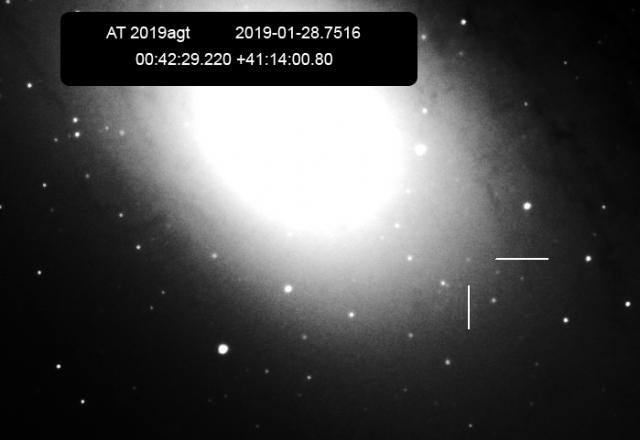› Forums › Spectroscopy › Possible nova in M31
- This topic has 24 replies, 7 voices, and was last updated 5 years, 2 months ago by
 George Carey.
George Carey.
-
AuthorPosts
-
29 January 2019 at 9:56 am #574242
 George CareyParticipant
George CareyParticipantNick James and I spotted this just after 6pm Monday 28th.
The Liverpool telescope has it on their list but have bad weather and M31 is getting rather low in the sky for them.
The nova is quite close to the core so may be a very difficult target for amateur spectroscopy.
https://wis-tns.weizmann.ac.il/object/2019agt
Attachments:
29 January 2019 at 9:58 am #580609 George CareyParticipant
George CareyParticipantImages
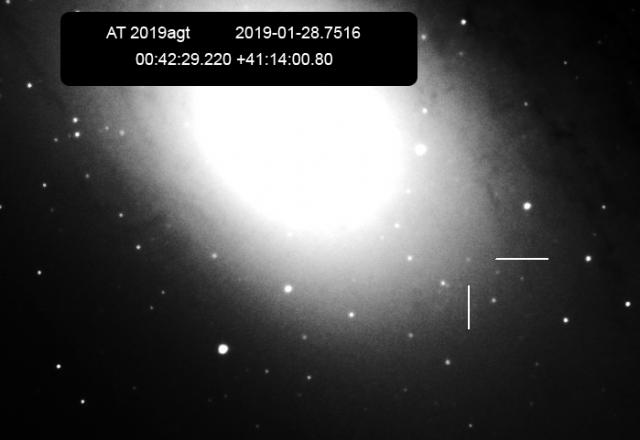
 29 January 2019 at 2:15 pm #580610
29 January 2019 at 2:15 pm #580610 Robin LeadbeaterParticipant
Robin LeadbeaterParticipantNice find George/Nick !
I saw this pop up on my TNS alert yesterday but the skies had just clouded over. You are probably right though unless it brightens a bit. mag 17 is extremely marginal for me for a spectrum with enough resolution for a firm confirmation (ALPY 600) and as you say, the bright background wont help. It is on my list though. (I am starting to look at the potential to confirm M31 novae spectroscopically so if you like, you can contact me direct for a confirming spectrum if you find something interesting. The M31 season is probably closing for this now though as I need at least a couple of hours fully dark and at good altitude)
Cheers
Robin
29 January 2019 at 5:46 pm #580611 Nick JamesParticipant
Nick JamesParticipantThere are at least four variable objects blinking on and off when I compare my median-subtracted frame from last night with one from early December. See if you can find them all here.
29 January 2019 at 6:43 pm #580612 Dr Paul LeylandParticipant
Dr Paul LeylandParticipantI make at least seven, most of which are quite faint. The pixel coordinates are close to (913,646), (708,707), (235,482), (274,843), (697,140), (939,483) and (562,850). This was only a casual inspection and there could well be more with a detailed search.
Hmm. Could be fun to write code to find these things.
29 January 2019 at 7:23 pm #580613 Grant PrivettParticipant
Grant PrivettParticipantYou got more than me!
Yeah, the coding is fun. More fiddly, than difficult. I wrote some in VB6 a few years ago – that used Source Extractor output, but it could just as easily have used Pisa or Daophot instead. I imagine many would use Python instead of VB6 these days. 🙂
29 January 2019 at 7:28 pm #580614 Robin LeadbeaterParticipant
Robin LeadbeaterParticipantOn it now with the ALPY 600. It is there but barely above the background. Perhaps a hint of broad H alpha. Rain is due in 10 mins so an hours worth is all I am going to get tonight.
 29 January 2019 at 8:10 pm #580615
29 January 2019 at 8:10 pm #580615 Robin LeadbeaterParticipant
Robin LeadbeaterParticipantVery noisy at an SNR of just ~3-4. A blue continuum with no obvious features (though they would have to be very strong to show at this SNR) There is an emission feature at H alpha at the expected local velocity (-500km/s) but it could equally well be just noise.
Robin
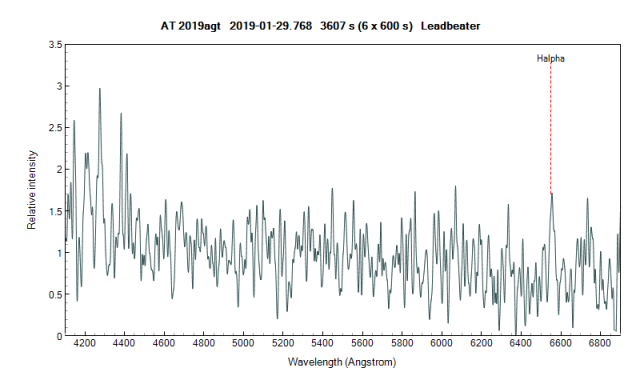 29 January 2019 at 10:45 pm #580617
29 January 2019 at 10:45 pm #580617 Rob JanuszewskiParticipant
Rob JanuszewskiParticipantWell done again George on another discovery.
Rob
30 January 2019 at 7:29 am #580618 Dr Paul LeylandParticipant
Dr Paul LeylandParticipantI’d use Perl myself but de gustibus non disputandum est. Further, I already have code to process Daophot and APT output and extending it to SExtractor shouldn’t be difficult. My comment was more about the image processing end of things, to see whether a targeted approach optimised for just the one problem could be better (by some measure) than a general purpose tool.
30 January 2019 at 3:35 pm #580619 George CareyParticipant
George CareyParticipantWell done Robin – may be a few clear hours tonight from my location.
You are right about the M31 season drawing to a close.
My image quality goes to pieces around the middle of February.
30 January 2019 at 3:59 pm #580620 George CareyParticipant
George CareyParticipantSome near the edge where the image overlap could be from a variety of causes.
I aligned the frames with Registar.
GIF too big for the forum, so loaded here: http://geoastro.co.uk/january2019/M31seq.gif
30 January 2019 at 6:21 pm #580621 Nick JamesParticipant
Nick JamesParticipantRobin, Impressive spectra given how faint this is. The sky is still getting dark here but the nova is considerably brighter than the 28th. I get 16.7 R tonight compared to 18.0 R two days ago.
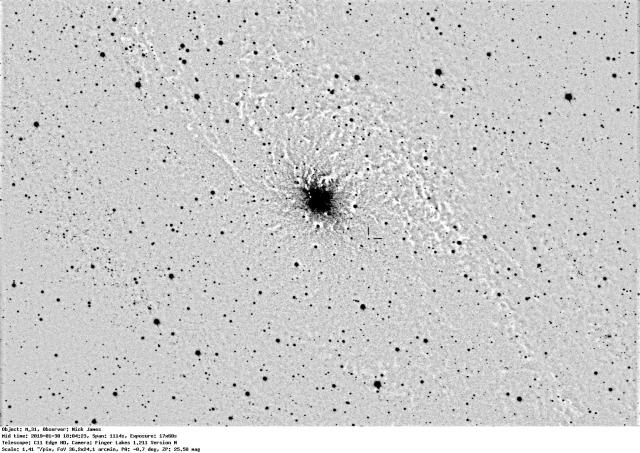 30 January 2019 at 6:40 pm #580622
30 January 2019 at 6:40 pm #580622 Nick JamesParticipant
Nick JamesParticipantAutomation of detection of transients is one of the things that even pros struggled with for a long time but they seem to have got it pretty well sorted now. I remember back in the late 90s helping Tom Boles with this and the main problem was that you had to accept a pretty high false alarm rate in order to avoid missing stuff. At that time it was just more efficient to blink manually.
I’ve got a large C library of image processing functions written over the years. One of them takes two images at the same scale, cross correlates them in the frequency domain to get alignment, attempts to blur the sharper one to get the same median PSF as the other one, normalises and then subtracts. I have to say that it is not brilliantly effective and that in the end I decided that I had more interesting things to do!
The human eye/brain combination takes some beating.
30 January 2019 at 7:02 pm #580623 George CareyParticipant
George CareyParticipantYes indeed, much brighter.
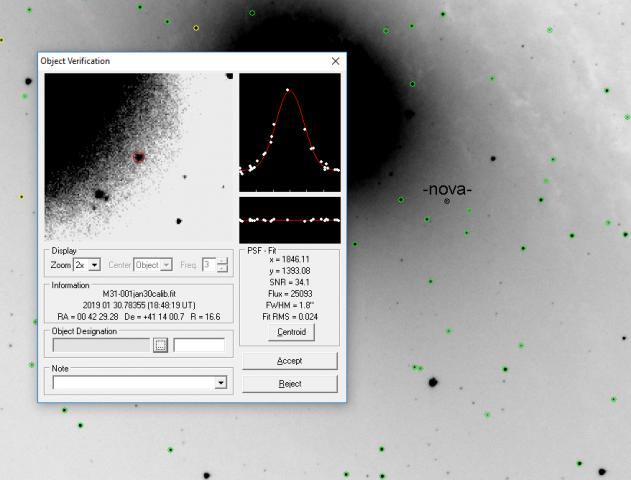 31 January 2019 at 12:38 am #580624
31 January 2019 at 12:38 am #580624 Nick JamesParticipant
Nick JamesParticipantThe arrows do make it much easier…
31 January 2019 at 11:30 am #580625 Robin LeadbeaterParticipant
Robin LeadbeaterParticipantI spent 2 more hours on the spectrum last night but no better. (The “light pollution” from the galaxy is just too much. The sky background in the slit is ~8x the star signal) so no spectroscopic confirmation yet I am afraid. If there is still no confirming pro spectrum I might try again in a few days when any characteristic spectral features should have developed more.
Robin
4 February 2019 at 11:58 pm #580644 Robin LeadbeaterParticipant
Robin LeadbeaterParticipantThe spectrum has now developed sufficiently to attempt a classification.
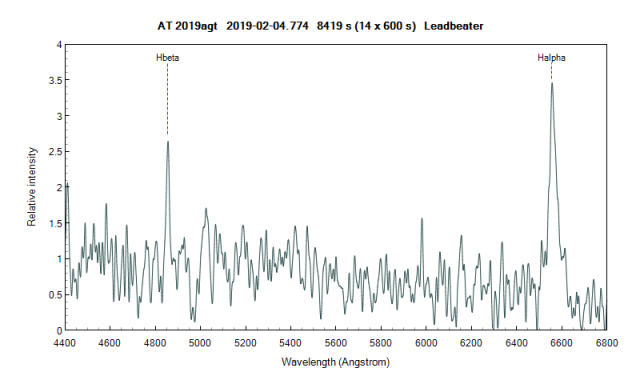
It shows a clear broad (~1600km/s FWHM ) Ha alpha emission line and an H beta emission line at the expected radial velocity for this region of M31 so in the absence of any professional spectra, I have classified it as a Nova in TNS.
Robin
5 February 2019 at 7:27 am #580645 Nick JamesParticipant
Nick JamesParticipantExcellent work Robin. Many thanks.
5 February 2019 at 10:58 am #580646 George CareyParticipant
George CareyParticipantSuperb work. Has this ever been done before – an amateur classification of an extra-galactic nova?
-
AuthorPosts
- You must be logged in to reply to this topic.

